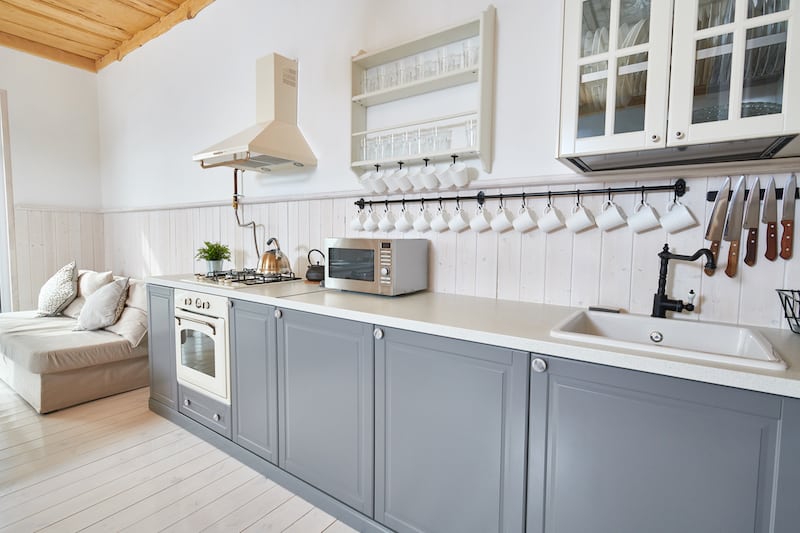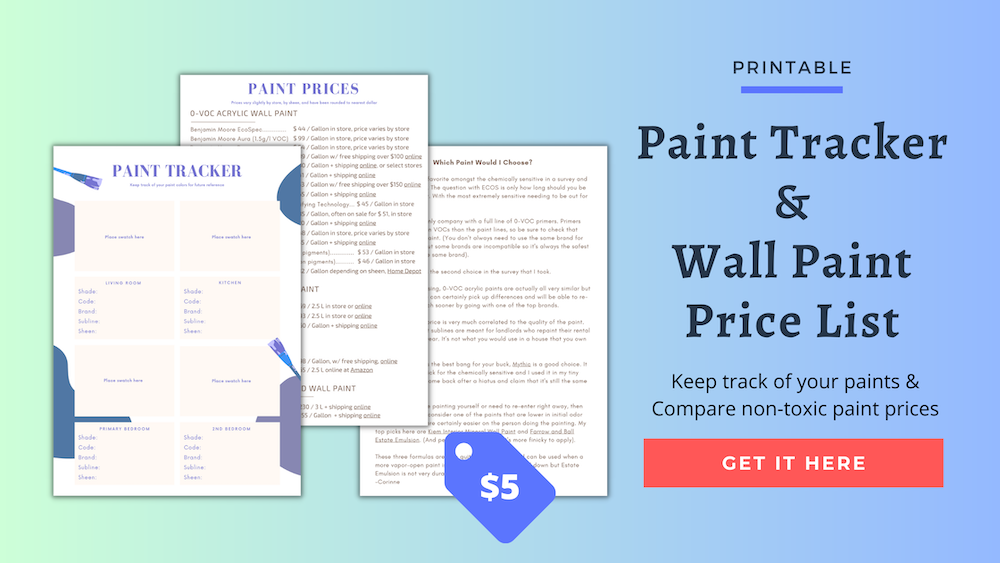Cabinet paint needs to be particularly durable. The most common types of cabinet paints are either solvent-based or oil-based paint and those are high in offgassing. The next most durable type is a water-based alkyd.
Painting your cabinets yourself isn’t an easy project but these are the non-toxic, low, and zero VOC paint options that work beautifully.
I would not consider using just a regular acrylic paint that isn’t formulated for cabinets, trim, and furniture since it’s not durable enough.
This article contains affiliate links, upon purchase I make a small commission at not extra cost to you.

1. AFM Safecoat Ecolacq
Ecolacq is an acrylic lacquer that works particularly well on cabinets. This is really the go-to low-VOC paint for cabinets and is the one that is most trusted by chemically sensitive folks.
The Ecolacq line has a primer as well. To get a totally professional look on cabinets it’s meant to be sprayed on.
2. Annie Sloan Chalk Paint
Chalk Paint works particularly well on cabinets – and it usually doesn’t need prep or primer (though you really should sand first). You do have to finish it with a topcoat. Wax is actually the most durable of the topcoats but there are water-based synthetic options as well.
I look more deeply into Annie Sloan in my mineral paint post.
Chalk Paint is also a great paint to go over shellac if you use shellac as a sanding sealer to block tannins from bleeding through.
If you want to paint over Chalk Paint then Farrow and Ball primer plus paint works well.
3. Farrow & Ball
Farrow and Ball Full Gloss Paint works well on cabinets. This is one of my favorite zero-VOC paint brands.
It is easy to wipe down and wash with a 95 percent gloss.
4. C2 Paint with PolyWhey
This is a urethane-modified acrylic paint made with whey from Vermont Natural Coatings. I personally really like Vermont Natural Coatings’ products, so I would be interested to try this paint.
They have a cabinet and trim paint that looks like an oil-based finish but is low-VOC.
5. Milk Paint
If you wanted to go with a 100% natural option you should consider Milk Paint. Milk Paint is essentially odorless and it’s the only paint that is made from 100% natural ingredients. The only challenge is that it needs a very durable topcoat to be considered for use in the kitchen.
Tung oil is a very durable oil that can be used as the topcoat. Though it does change the color of the paint substantially. You can see photos of what that looks like here.
If you are extremely chemically sensitive or are dedicated to a totally natural option you could consider this combo. Check out this photo of cabinets painted with Milk Paint for inspo, though in this case they top coated it with conversation varnish (which is not exactly non-toxic).
6. Linseed Oil Paint
Another completely natural option is a linseed oil-based paint. Earth and Flax, and Allback are solvent-free brands that you can buy in North America. AFM Naturals is another good brand but with a solvent.
Since cabinetry can be a combination of wood types (often plywood and hardwood fronts for example) a shellac primer can be helpful to create a consistent substrate for the paint, it will hide the differences between the different materials.
Wiping on the paint versus brushing it on can help to avoid brush strokes.
Natural oil paints are very durable.
Related Posts:
- Non-toxic cabinet brands
- Non-toxic bathroom vanities

Corinne Segura holds certificates in Building Biology, Healthier Materials and Sustainable Buildings, and more. She has 10 years of experience helping others create healthy homes.

Mae
Hi Corinne, I was wondering your opinion on something if you see this. My family is extremely sensitive/ allergic to isothiazol. We were considering purchasing a home that was just recently painted with a paint with isothiazol. We got very symptomatic there, but there was also a floor that we do not react well to that we were going to remove upon purchase. Do you think the house could be repainted? It is such a financial gamble, I am concerned.
Thank you so much for any response you may have,
Mae
Bonnie
Thoughts on Benjamin Moore Insl-X Cabinet paint? Says low voc. On SDS I see VOC Regulatory Limit (g/L) <50 but no actual VOC g/L listed. Thank you
Rachel Quigley
My cabinet man uses EVO® ECLIPSE CLEAR TINT BASE by Gemini Coatings because he says it gives a superior hard smooth finish. He says the cabinets will have no odor upon installation. Data sheet says it is Low VOC, HAPs Free, Formaldehyde Free, and Phthalate Free. There is no Calif Prop 65 warning. However, when I read about the active ingredient, 2-Butoxyethanol, there is some evidence of cancer and reproductive effects due to inhalation, oral, or skin exposure.
But since the product will be dried on the cabinet, do I need to worry? I won’t be breathing the fumes from the liquid and obviously not drinking it. I will touch the cabinets, but they are probably referring to pouring the liquid on your skin. I’m driving myself crazy with this. I’m “buying you a coffee” right now because I need to know so I can stop obsessing! Thanks!
Here are the Safety Data Sheets:
https://www.gemini-coatings.com/wp-content/uploads/2022/02/ECLCB-0410_ECLCB-0420_ECLCB-0430_ECLCB-0460_ECLIPSE_CLEAR_TINT_BASE_4.pdf
https://www.gemini-coatings.com/wp-content/uploads/2021/05/ECLCB-0430-_CAEN.pdf
Ginger Russell
Did you ever find out anything about the cabinet paint or topcoat? I’m also driving myself crazy! Cabinet makers said they have a low voc option of Imron industrial wood tuf2002 but it’s data sheet has no ingredients and seemingly high voc.
Anais
We just updated some cabinets with F&B. Very happy with the results. Thanks so much!
Corinne
nice!
Sarah Makari
How about Sherwin Williams low VOC like the ones used by cabinets.com? I am seriously considering cabinets.com because they are low cost and claim to use only plywood and solid wood. Would love your feedback. By the way, I am a huge fan of everything you post! Thank you!
DOROTHY N MORGAN
Thank you. This informatiin is truly needed. We’re working on a toxic free home at this very moment.
Corinne
You’re welcome